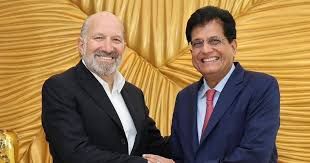4 red lines in India-US trade talks: Corn, ethanol, soyabean & dairy

India and the United States have taken strong steps toward deeper economic and strategic ties. But when it comes to trade, agriculture continues to be a major hurdle. Four commodities—corn, ethanol, soyabean, and dairy—have emerged as the most difficult areas of negotiation.
These products represent India’s “red lines” in the talks. They involve not just economics, but also culture, regulation, and farmer livelihoods. The road to a full trade deal remains rocky unless both sides find common ground.
1. Corn: India Pushes Back Against GM Imports
The United States wants India to lower tariffs on American corn. Most U.S. corn is genetically modified (GM), which raises concerns in India.
India has not approved GM corn for commercial use or public consumption. The government worries about its impact on health, biodiversity, and farmer rights. Farmers also fear that cheap U.S. corn could undercut local prices.
India’s position is firm. It wants to protect its food system, which supports millions of small farmers. For New Delhi, the corn debate isn’t just about trade—it’s about food safety and national interest.
2. Ethanol: India’s Blending Targets vs. U.S. Export Goals
India has set ambitious goals for green fuel. It plans to blend 20% ethanol in petrol by 2025. Most of this ethanol comes from sugarcane and rice grown within the country.
The U.S. sees India’s demand for ethanol as a business opportunity. It wants New Delhi to allow more ethanol imports, especially from corn-based ethanol.
But India is hesitant. Officials believe that relying on foreign ethanol could hurt local production and reduce energy independence. The government also wants to support Indian farmers who benefit from ethanol incentives.
So, while both countries agree on cleaner energy, their priorities don’t match when it comes to sourcing.
3. Soyabean: The GMO Dispute Continues
Soyabean is another flashpoint. Like corn, most soyabean grown in the U.S. is genetically modified. India has not approved GM soyabean for food or farming.
The Indian government takes a precautionary approach. Its food safety regulators impose tight rules on GM imports. These measures frustrate American exporters, who see them as non-tariff barriers.
Indian soyabean farmers also oppose imports. They fear that cheaper U.S. soyabean could lower market prices and impact their income.
This issue highlights a deep divide. The U.S. supports a trade model led by science and global standards. India prefers to protect its food system through stricter regulation.
4. Dairy: Cultural Beliefs Shape Trade Policy
Dairy remains the most sensitive issue in these talks. The U.S. wants India to relax rules and allow more dairy imports. But New Delhi refuses to change one key requirement: imported dairy must come from cows not fed animal-based feed.
This rule reflects India’s religious and ethical values. Many Indians avoid animal-derived products. Cow protection also plays a central role in Hindu belief systems.
Beyond faith, India also wants to protect its dairy industry. It is the largest milk producer in the world. Most of the sector is made up of small, rural farmers. Opening up to large U.S. dairy firms could threaten their survival.
For India, dairy isn’t just a business. It’s a cultural and livelihood issue.
Diplomatic Outlook
Despite these clashes, both countries want stronger trade ties. In fact, smaller deals in other areas—like digital trade and pharmaceuticals—have already moved forward.
However, agriculture continues to block a full deal. The Indian government must defend domestic interests, especially with farmers playing such a large political and economic role. U.S. negotiators, on the other hand, face pressure from powerful agri-business groups.
Trade officials on both sides admit that progress is slow. But the talks are still alive. Dialogue continues in hopes of finding practical middle ground.
What’s at Stake?
These red lines are more than policy points. They touch real lives—of farmers, small business owners, and rural workers. Any decision on trade will affect millions.
India wants to ensure food security, protect its environment, and preserve cultural norms. The U.S. wants fair access to a growing market. Both sides have valid concerns.
But unless they approach talks with flexibility and respect, a wide-ranging trade deal may remain out of reach.
Conclusion
India-US trade talks offer great promise, but real progress depends on solving tough issues. Corn, ethanol, soyabean, and dairy are more than trade items—they reflect deeper questions of trust, tradition, and self-reliance.
Both nations need to find a balance between global trade ambitions and domestic needs. Only then can they unlock the full potential of their economic partnership.






